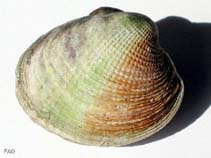Austrovenus stutchburyi (Wood, 1828)
Stutchbury's venus| Native range | All suitable habitat | Point map | Year 2050 |

|
| This map was computer-generated and has not yet been reviewed. |
| Austrovenus stutchburyi AquaMaps Data sources: GBIF OBIS |
Classification / Names आम नाम | उपशब्द | CoL | ITIS | WoRMS
Bivalvia | Venerida | Veneridae
Environment: milieu / climate zone / गहराई सीमा / distribution range पारिस्थितिकी
; गहराई सीमा 0 - 5 m (संदर्भ 101364). Temperate, preferred 14°C (संदर्भ 107945); 34°S - 53°S, 68°E - 175°W
Distribution देश | ऐफ ऐ ओ क्षेत्र | Ecosystems | संयोग | भूमिका
Southwest Pacific and Antarctic Indian Ocean: New Zealand, Chatham Island and Kerguelen. Temperate to polar.
Length at first maturity / आकार / Weight / Age
परिपक्व अवधि: Lm ?, range 2 - ? cm Max length : 4.9 cm SHL पुल्लिंग / अलिंग; (संदर्भ 126738); अधिकतम सूचित उम्र: 20 वर्षो (संदर्भ 126742)
Life cycle and mating behavior परिपक्व अवधि | पुनरुत्पत्ति | मछलीऔ का अंडे देना | Eggs | Fecundity | Larvae
Main reference
संदर्भ | संयोजक | सहयोगीयो
Spurgeon, A. 2007 New Zealand Mollusca. http://www.mollusca.co.nz/index.php (संदर्भ 8121)
IUCN Red List Status
(संदर्भ 130435: Version 2025-1)
CITES status (संदर्भ 108899)
CMS (संदर्भ 116361)
Threat to humans
Human uses
मात्स्यिकी: व्यापारिक
FAO - मात्स्यिकी: landings | FishSource | Sea Around Us
साधन
अधिक जानकारी
इंटरनेट स्रोत
BHL | BOLD Systems | CISTI | DiscoverLife | FAO(मात्स्यिकी: ; publication : search) | Fishipedia | GenBank (genome, nucleotide) | GloBI | Gomexsi | Google Books | Google Scholar | Google | PubMed | Tree of Life | Wikipedia (Go, खोज) | Zoological Record



